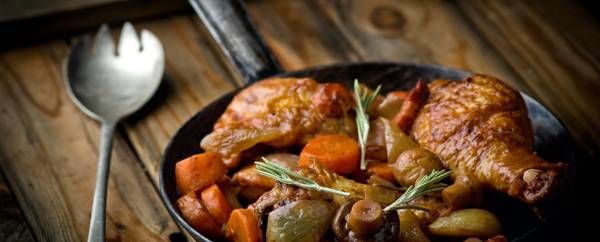Types of meat: Which one is better for each dish?
What kind of meat is best for my stew to come out good? And which part of the lamb is the most tender? What is skirt and needle? If you like to cook, but you do not know how to distinguish what type of meat you need for each dish, we will clear all your doubts below.
how to shop
Share

What types of meat are there?
Knowing how to identify the type of meat or the piece that we should use for each recipe is not always easy, however, it is an important decision, since the success of each dish depends, to a great extent, on it. Although each animal has its own types of cut or parts, whose name may vary depending on the geographical area where we are, mainly, we can include the types of meat in two large groups: red meat and white meat.
Red and white meat
Red meat
- Includes meat: veal, lamb, cow, ox and goat.
- Red meat is named for its color, since it has a high content of myoglobin, a pigment very rich in iron.
- They have much more heme iron, which is easier for the body to assimilate.
- It is a meat with more purines.
- It is juicier than white meat because it contains more fat, including saturated fat.
White or lean meat
- Includes meat: chicken, rabbit, quail, partridge and turkey.
- It has less iron, but the proteins it provides have a higher biological value.
- It has less saturated fat than red meat.
- It is easier for the body to digest.
Lamb meat and pork meat can vary between red meat or white meat, depending on the age of the animal or the part of the body that is consumed.

Types of meat according to animal origin
Within cattle, meats can be classified according to whether they are white or red meat. The former refer to meats from young animals, such as veal, while red meats are those obtained from adult animals such as cows.
Within the variety of beef, we can distinguish:
- The dairy calf is the meat that we obtain from the youngest animal and that has only fed on mother's milk. The color of this meat is pinkish white, a characteristic due, in part, to the fact that the animal has never tasted grass, which makes its meat more tender and with a delicate flavor.
- The yearling, on the other hand, is the veal meat that corresponds to young beef, that is, one that is between 10 and 18 months old.
This meat has a high level of macronutrients, which vary in terms of the age of slaughter and the piece of consumption. The lean parts are rich in nutrients and have a high level of protein and minerals such as iron and zinc. As for its vitamin content, beef is rich in B vitamins.
Poultry meat
- Duck meat
Duck meat is considered one of the great protagonists of French gastronomy and, although its consumption is widespread throughout the world, its demand is increasing in our country more and more, since almost everything from the duck is used and it gives rise to preparing endless different and delicious dishes.
Duck meat is rich in water and, like all meats, contains proteins of high biological value. The caloric intake of the duck is higher than that of the rest of the birds, but it varies depending on the skin of the animal, since most of the fat is found there. Once the skin is removed, the duck meat becomes lean, with a low fat component, which also abounds in different types of micronutrients, such as potassium. In addition, it is rich in zinc and vitamins of groups A and B.
Turkey belongs to the group of so-called white meats, like chicken and rooster. This means that they are low-fat and low-calorie meats.
Turkey meat is made up of almost 80% water and, like all meats, it is rich in proteins of high biological value and does not contain carbohydrates. This type of meat is rich in B vitamins, such as vitamin B3, B6 and B12.
The chicken is the breeding gallinaceous bird (male or female), slaughtered with a maximum age of 20 weeks. Depending on the conditions of the breeding of this animal, we can differentiate between two types of chicken:
- Free-range chicken: it is fed with grain, in semi-freedom and without receiving medication, it can be distinguished at a glance because it has a more yellowish color and a more intense flavor.
- Industrial chicken: it is the one that is massively raised on farms, its meat is whitish and has a less intense flavor.
In addition to the one defined as chicken, other types can be differentiated depending on the sex and age of the specimen at the time of slaughter: the picantón chicken, the tomato chicken or coquelet, the poularde, the capon and the hen.
Chicken meat is made up of 70% water, is rich in protein and is very easy to digest. Regarding its nutritional composition, there are differences in the composition of the different meat pieces of the animal, as in the case of the breast, whose protein content is higher than that of the thigh. Regarding the vitamin content, the presence of folic acid and vitamin B3 (niacin) stands out. Among the minerals, the level of iron and zinc is lower than in the case of red meat, although it is a more important source of phosphorus and potassium.
Rabbit meat is one of the most valued meats in the Mediterranean diet. It is a soft meat, with a very good texture, a non-greasy consistency and a very subtle aroma.
This type of meat has a high water content and can be considered lean, that is, it hardly contains fat and does not have carbohydrates. Rabbit meat has a low uric acid content, which makes it more tolerable for people with gout. In addition, it has a high protein content of biological value and is a source of phosphorus and potassium.
The pig is the animal from which the largest amount of food can be used. An extensive range of products is made from its meat, which are part of the culinary richness of many geographical areas.
The pig provides a large amount of protein of high biological value, which helps the growth of the muscular system. The amount of fat will depend on the part of the pig that we consume, since, while the lean parts have a very low level of fat, others, such as semi-fat meats, have a higher lipid content. In addition, the lack of carbohydrates makes lean parts, such as loin or sirloin, ideal for people who follow diets aimed at reducing weight.
Regarding its level of vitamins, pork is one of the meats that contains the highest level of thiamine, through which carbohydrates are assimilated, as well as vitamins of group B, potassium, phosphorus and zinc.
Lamb meat is the meat from the breeding of the sheep (male or female) destined for human consumption. Depending on the time of his sacrifice, we can distinguish between:
- Suckling lamb: if the animal is slaughtered within less than 30 or 40 days of birth.
- Ram: if the animal is slaughtered after 300 days of life.
This type of meat can be considered as fatty meat, although the amount of it varies depending on the age of the lamb and the piece that is consumed. Thus, as the age of the slaughtered animal increases, the amount of fat increases. In this way, suckling lamb meat is the one that contains less fat. On the other hand, lamb chops are the fattest part of the animal, however, in the leg of lamb the fat content is reduced by half.
The lamb carde has a tender and tasty texture. In addition, it is rich in proteins of high biological value with a high content of essential amino acids, iron and B vitamins.

The best type of meat for each dish
Depending on the dish we want to prepare, there are certain types of meat that are more recommended than others.
Red meats: beef, pork and lamb
- For stews or stews: The best meats for stewing are the smoothest, gelatinous type. They are meats, apparently hard before cooking, but that later become sweet and soft after cooking over low heat. This is because the collagen in its fibers gels. Tender and juicy cuts are recommended so that, after cooking, they almost fall apart and the meat is not dry. The best parts are the ribs and the brisket.
- For roasts: generally, the best pieces for roasting are those of superior categories, that is, large pieces that have 'clean' meat (without fiber) and juicy, regardless of whether they are pork, beef or lamb. But, if we opt for beef, we recommend the sirloin and high loin for roasting and the rump or ribs for baking. With the lamb, the shoulders, legs and carré (joined and boneless chops) are the tastiest pieces. If we want to roast a suckling pig or suckling lamb, it is recommended to buy half or a quarter of the animal.
- For frying or breading: for this type of dish we will be served less 'showy' pieces of meat, but just as tasty, such as tapa, ham fillet or veal round, since the breading or batter will 'make up' them a bit, while protecting them from the temperature, making them tender.
- To grill: very noble pieces are recommended, with little fat, such as sirloin, chops or loin.
White meats: chicken, turkey and rabbit
- For stews or stews: although any poultry meat is suitable for stews, rabbit is the most common white meat used in stews and rice dishes due to its easy digestion, in addition to its low fat and calorie content.
- For roasts: if what we want to do is a roast, it is advisable to buy the whole chicken or turkey, and if what we want is to stuff it, it is recommended to order it boneless. In general, we can use all the parts of the chicken for cooking, indistinctly, although the lower parts are the least dry, such as the thighs, the thighs and the drumsticks, so they will be tastier in the oven.
- For grilling, frying or breading: although any cut of poultry is good for a stew, breasts are the most recommended for grilling or breading, due to their ease of filleting.
However, if when you go shopping you have doubts about whether to choose one piece or another, always ask your master of freshness, who will advise you on what type of meat will be best for each dish.
Recipes with each type of meat
If you want to discover new recipes with different types of meat, we recommend you take notes of the ones we present below.






